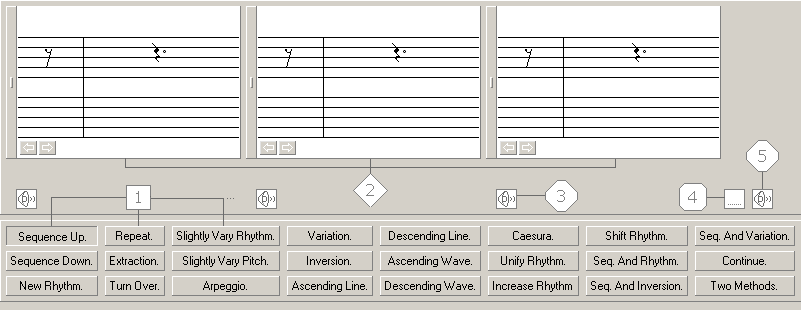On the interface level each method has its own tab (see Figure 1). The table
below describes each item on the Figure 1.
 |
Sequence Up. The original Motive notes are moved up. |
 |
Sequence down. The original Motive notes are moved down. |
 |
New Rhythm. The method composes a new rhythm for the Motives. |
 |
Repeat. The first motive is just a repetition of the original
Motive. The second Motive on the panel is the original Motive transposed
one octave up. The third Motive is the original Motive transposed one octave
down. |
 |
Extraction. Three Motives, developed by notes extraction out
of the original Motive. |
 |
Turn Over. The rhythm and the intonation content of the first
Motive are turned. Only the intonation content is turned in the second Motive.
The rhythm of the third Motive is turned. |
 |
Slightly vary rhythm. The method slightly varies the rhythm of
the initial Motive. |
 |
Slightly vary pitch. The method slightly varies the intonation
content of the initial Motive. |
 |
Arpeggio. This method changes the non-chord tones of the Motive
on the chord tones. |
 |
Variation. The variation of the initial Motive. |
 |
Inversion. All intervals of the first Motive are inverted. Each
second interval of the second Motive is inverted. For the third Motive,
the algorithm chooses intervals randomly. After that the program inverts
these intervals. |
 |
Ascending line. The program uses various methods of motive development
to create one thousand Motives. Then the program chooses only the Motives,
which have the form of an ascending line. Also, the program moves the notes
of the each Motive to smooth the transition from the previous Motive to
the new Motive. |
 |
Descending line. The program uses various methods of motive development
to create one thousand Motives. Then the program chooses only the Motives,
which have the form of a descending line. Also, the program moves the notes
of the each Motive to smooth the transition from the previous Motive to
the new Motive. |
 |
Ascending wave. The program uses various methods of motive development
to create one thousand Motives. After that the program chooses only the
Motives, which have the form of an ascending wave. Also, the program moves
the notes of the each Motive to smooth the transition from the previous
Motive to the new Motive. |
 |
Descending wave. The program uses various methods of motive development
to create one thousand Motives. Then the program chooses only the Motives,
which have the form of a descending wave. Also, the program moves the notes
of the each Motive to smooth the transition from the previous Motive to
the new Motive. |
 |
Caesura. The method emphasizes the end of the Motive by a pause
or large duration. Read the more detailed description of the caesura term
here. |
 |
Unify rhythm. The method changes all the durations of the first
Motive to a sixteenth duration. An eighth duration is used for second Motive
and a quarter duration is used for the third Motive. |
 |
Increase rhythm. The method adds a sixteenth duration to the
all durations of the first Motive. An eighth duration is used for second
Motive and a pointed eighth duration is used for the third Motive. |
 |
Shift rhythm. For the first Motive, the method shifts the time
of the all notes by a sixteenth duration. The eighth duration is used for
second Motive and the pointed eighth duration is used for third Motive. |
 |
Sequence and new rhythm. The program composes a new rhythm for
the intonation content of the initial Motive. Then the program moves the
notes of the each Motive to smooth the transition from the previous Motive
to the new Motive. |
 |
Sequence and inversion. Firstly, the method inverts the initial
Motive (see method 'Inversion'). Then the program moves the notes of the
each Motive to smooth the transition from the previous Motive to the new
Motive. |
 |
Sequence and variation. Firstly, the method varies the initial
Motive. After that, the program moves the notes of the each Motive to smooth
the transition from the previous Motive to the new Motive. |
 |
Continue. The program moves the notes of the initial Motive to
smooth the transition from the previous Motive to the new Motive. |
 |
Two methods. Two randomly-chosen methods of the Motive development
are used to create new Motives. |
Copyright (c) 2003 - 2005 Ilya Schepikhin. All rights reserved.


























 on Figure 2, the panel
in the middle part of the main window appears. This panel contains the three Motives
(see number
on Figure 2, the panel
in the middle part of the main window appears. This panel contains the three Motives
(see number  on Figure
2). There is a button under the each Motive (see number
on Figure
2). There is a button under the each Motive (see number
 on Figure 2). If you press
this button then the program plays the corresponding Motive. Some panels have an
additional button (see number
on Figure 2). If you press
this button then the program plays the corresponding Motive. Some panels have an
additional button (see number
 on Figure 2). If you press
this button then the program generates the three new Motives. If you press the button
signed by number
on Figure 2). If you press
this button then the program generates the three new Motives. If you press the button
signed by number  on Figure
2 then the program plays the all three Motives.
on Figure
2 then the program plays the all three Motives.